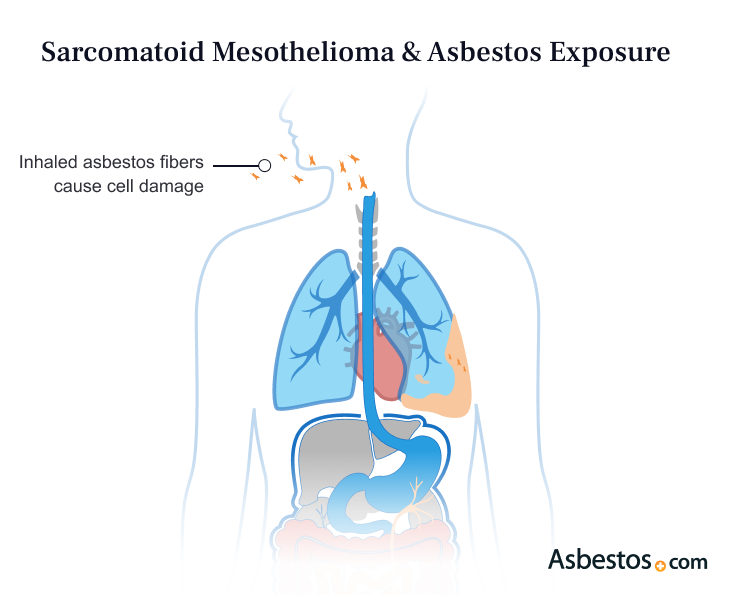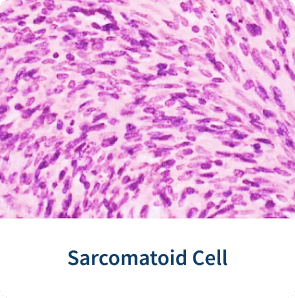Based on Your Reading:
Get Your Free Mesothelioma Guide

Find a Top Mesothelioma Doctor

Access Help Paying for Treatment

Sarcomatoid malignant mesothelioma is a rare asbestos-related cancer that primarily develops in the lining of the lungs. The sarcomatoid cells that make up these mesothelioma tumors are resistant to treatment, but evidence shows the condition responds best to immunotherapy.
Written by Karen Selby, RN • Edited By Walter Pacheco • Medically Reviewed By Dr. Jacques Fontaine
The Mesothelioma Center at Asbestos.com has provided patients and their loved ones the most updated and reliable information on mesothelioma and asbestos exposure since 2006.
Our team of Patient Advocates includes a medical doctor, a registered nurse, health services administrators, veterans, VA-accredited Claims Agents, an oncology patient navigator and hospice care expert. Their combined expertise means we help any mesothelioma patient or loved one through every step of their cancer journey.
More than 30 contributors, including mesothelioma doctors, survivors, health care professionals and other experts, have peer-reviewed our website and written unique research-driven articles to ensure you get the highest-quality medical and health information.
My family has only the highest compliment for the assistance and support that we received from The Mesothelioma Center. This is a staff of compassionate and knowledgeable individuals who respect what your family is experiencing and who go the extra mile to make an unfortunate diagnosis less stressful. Information and assistance were provided by The Mesothelioma Center at no cost to our family.LashawnMesothelioma patient’s daughter


Selby, K. (2024, April 18). Sarcomatoid Mesothelioma. Asbestos.com. Retrieved April 18, 2024, from https://www.asbestos.com/mesothelioma/malignant-sarcomatoid/
Selby, Karen. "Sarcomatoid Mesothelioma." Asbestos.com, 18 Apr 2024, https://www.asbestos.com/mesothelioma/malignant-sarcomatoid/.
Selby, Karen. "Sarcomatoid Mesothelioma." Asbestos.com. Last modified April 18, 2024. https://www.asbestos.com/mesothelioma/malignant-sarcomatoid/.
Sarcomatoid malignant mesothelioma is a rare type of asbestos-related cancer. This cancer can affect the lining of the lungs, heart, abdomen or testes. “Sarcomatoid” refers to the tumor cell type. These cells make up most of the tumors for this type of mesothelioma.
“Sarcomatoid mesothelioma is a rare subtype in contrast to epithelial. Sarcomatoid tends to be a little more locally progressive.”
Sarcomatoid cells grow in connective tissues, such as bones, nerves and tendons. The sarcomatoid type is the rarest of the 3 primary cell types of mesothelioma. For comparison, about 60% of patients have the epithelial type, and 20% have the biphasic type.
Tumors of the sarcomatoid cell type are more likely to spread to new areas. They’re also more resistant to treatment. These characteristics contribute to the poor prognosis associated with this type of mesothelioma. Thankfully, advances in immunotherapy have helped some sarcomatoid patients far surpass their prognosis.
Asbestos is the primary cause of sarcomatoid malignant mesothelioma. Breathing or swallowing asbestos fibers lead to their accumulation in the body. Over time, irritation and inflammation cause mesothelial cells to turn cancerous.

Mesothelioma risk factors include asbestos exposure on the job, in the military and from the environment. Workers have been exposed primarily at industrial job sites, and veterans were exposed in shipyards and military bases. Secondary exposure also occurred when workers unknowingly brought asbestos fibers home.
The most common symptoms of the sarcomatoid mesothelioma type that develops in the lining around the lungs are shortness of breath, chest pain and coughing. Severe symptoms include difficulty breathing and persistent cough.
Most symptoms depend on tumor location. Sarcomatoid cells are most often found in pleural disease that develops in the lining of the lungs. However, patients with sarcomatoid peritoneal cancer will have abdominal symptoms instead. They may experience bowel problems, abdominal pain and swelling.
According to a 2023 medical review, symptoms of sarcomatoid mesothelioma are nonspecific, which means patients often don’t report specific symptoms with the disease that may help identify it. Symptoms often resemble those of more common illnesses like bronchitis. In addition, sarcomatoid mesothelioma symptoms can take between 20 and 60 years to appear after the initial asbestos exposure.
If you have any symptoms or a history of asbestos exposure, speak with a specialist as soon as possible. If you have a history of asbestos exposure, speak with your doctor about early screening. More treatment options may be available with an early diagnosis.
Get Your Free Mesothelioma Guide

Find a Top Mesothelioma Doctor

Access Help Paying for Treatment


When patients go to the doctor with mesothelioma symptoms, doctors order imaging tests. If X-rays reveal abnormalities, they’ll collect a tissue sample for a biopsy. Another doctor reviews the sample under a microscope and creates a pathology report.
Doctors use biopsies to confirm a sarcomatoid mesothelioma diagnosis. Only a biopsy can show specific details such as cell type.
Pathology stains are chemical laboratory tests that make cell features stand out under a microscope. Sarcomatoid cells are long, narrow and shaped like spindles.
Doctors diagnose 300 to 600 new patients with this cell type yearly. About 98% of these patients have pleural mesothelioma and about 2% have peritoneal mesothelioma.
Your pathology report describes the tumor cell type, biomarkers and cancer stage. Your doctor uses the findings to complete your diagnosis. Ask your doctor about your report and how it affects your treatment options.
“Most patients don’t know their cell type when I initially speak with them. I help them review their pathology report and explain what sarcomatoid cell types are and what this means for them.”
Patient Advocates can walk you through each section of the report to make sure you have a good understanding of what it says. They can answer questions about how a sarcomatoid diagnosis may impact treatment and prognosis.
Immunohistochemical markers, or biomarkers, can indicate how to treat your cancer. These markers are like flags telling your doctor which drugs work best. For example, if sarcomatoid cells in your tumor express high levels of PD-L1, that will appear when a pathologist stains them. Checkpoint inhibitor drugs such as Opdivo and Yervoy may be the most effective in this case.
Rare sarcomatoid mesothelioma cell subtypes can provide information about your prognosis. These types come in three categories. Some may provide a better prognosis. Others can point to a higher chance of metastasis.
These sarcomatoid mesothelioma subtypes are generally rare. They most often develop in the pleura of the lungs. Ask your physician whether there are any abnormalities in your pathology report. They can offer more information on your prognosis.
The median overall survival for sarcomatoid mesothelioma was 15 months with immunotherapy and 10.7 months with chemotherapy in a recent study. Each patient’s prognosis differs based on health, tumor location and metastasis. Doctors use data from the recent past to make prognosis estimates for sarcomatoid mesothelioma life expectancy.
Patients with pleural sarcomatoid mesothelioma survive about five months. The life expectancy for peritoneal mesothelioma patients is about 10 to 11 months after diagnosis. Women with the sarcomatoid type tend to live longer than men.
The most impressive advancement for checkpoint blockade has been the demonstration that for people with sarcomatoid and biphasic mesothelioma, we can double survival with the combination of ipilimumab and nivolumab.
Characteristics of these cells contribute to the prognosis of sarcomatoid mesothelioma. Their shape causes them to break apart rather than stick together. This separation allows for metastasis, when the cancer cells travel to new areas and form tumors. Sarcomatoid cells also recur quickly after treatment.
These factors make the cancer likely to return and spread after treatment. However, some sarcomatoid patients have lived for years thanks to breakthroughs in immunotherapy. New therapies available through clinical trials may work better for some patients.
Following rounds of chemotherapy, Wally Rogers’ tumors began growing again. Diagnosed with sarcomatoid mesothelioma, his tumors were particularly difficult to treat. After connecting with a specialist who recommended immunotherapy, he began Keytruda. Follow-up tests showed an almost immediate effect on the hard-to-treat cancer. CT scans showed no sign of remaining tumor cells.
Sarcomatoid mesothelioma treatment options differ for each patient based on cancer stage, tumor extent and overall health. For example, surgery isn’t generally recommended because this cell type tends to recur quickly. However, surgery is considered when peritoneal patients respond to immunotherapy.
Recent research suggests immunotherapy may have long-lasting beneficial effects in the sarcomatoid patients who respond to the treatment. Tumor Treating Fields therapy or noninvasive electrical pulse treatment, however, hasn’t shown the same effectiveness for sarcomatoid tumors in recent research. Consulting a mesothelioma specialist at a top cancer center is the best way to learn all your options.
“Sarcomatoid mesothelioma is a little less responsive to chemotherapy,” mesothelioma specialist Dr. Andrea Wolf of Mount Sinai Hospital told The Mesothelioma Center at Asbestos.com. “But from what we see from more recent data, it may be more responsive to immunotherapy. And we have additional treatment options for those patients.”
Sarcomatoid patients may consider palliative care, which aims to relieve symptoms and improve quality of life. Only about 48% of mesothelioma patients who responded to The Mesothelioma Center’s 2023 survey reported taking advantage of palliative care.

Sarcomatoid mesothelioma is generally considered incurable. Surgery isn’t typically recommended for sarcomatoid mesothelioma. Other treatments including immunotherapy, chemotherapy and radiotherapy are unlikely to be curative. There may be occasional instances of very long-term survival in sarcomatoid mesothelioma treated with immunotherapies.
Answered By: Anna Nowak, internationally renowned asbestos researcher and mesothelioma advocate
You can get sarcomatoid mesothelioma treatment from a mesothelioma specialist at a top treatment center. This cell type is more challenging to treat and requires an expert. Mesothelioma specialists work at the best cancer centers, which are often located in major metropolitan areas throughout the country.
You can prevent sarcomatoid mesothelioma by avoiding asbestos exposure. Exposure tends to happen at job sites or from damaged materials containing asbestos. Find out whether you have asbestos-containing materials in your home. If you do, take steps to prevent exposure, such as hiring an abatement professional.
Yes, researchers are working on novel ways to treat sarcomatoid mesothelioma. Some patients have found success with new immunotherapy drugs in clinical trials. You may be eligible to join a clinical trial and receive the latest medication that targets sarcomatoid cells. Ask your mesothelioma specialist which treatments are right for you.
Yes, sarcomatoid mesothelioma and carcinoma are two different types of cancer with unique origins and characteristics. Sarcomatoid malignant mesothelioma is a subtype of mesothelioma. This cancer arises from the mesothelial cells that line the lungs, abdomen or heart. The sarcomatoid type involves spindle-shaped or elongated tumor cells. These cells resemble those in sarcoma, a cancer that arises from connective tissue.
Sarcomatoid carcinoma is a subtype of carcinoma. This cancer occurs in the epithelial cells that line various organs and tissues. It can develop in several organs, including the lungs, liver and pancreas. Treatment is often different between the two types based on location and stage.

Have a question? Contact one of our Patient Advocates and get the answers you need.

Connect, share stories and learn from the experiences of others coping with mesothelioma in one of our support groups.

We help support charities, hospitals and awareness groups working to help people impacted by asbestos and cancer.
Your web browser is no longer supported by Microsoft. Update your browser for more security, speed and compatibility.
If you are looking for mesothelioma support, please contact our Patient Advocates at (855) 404-4592
